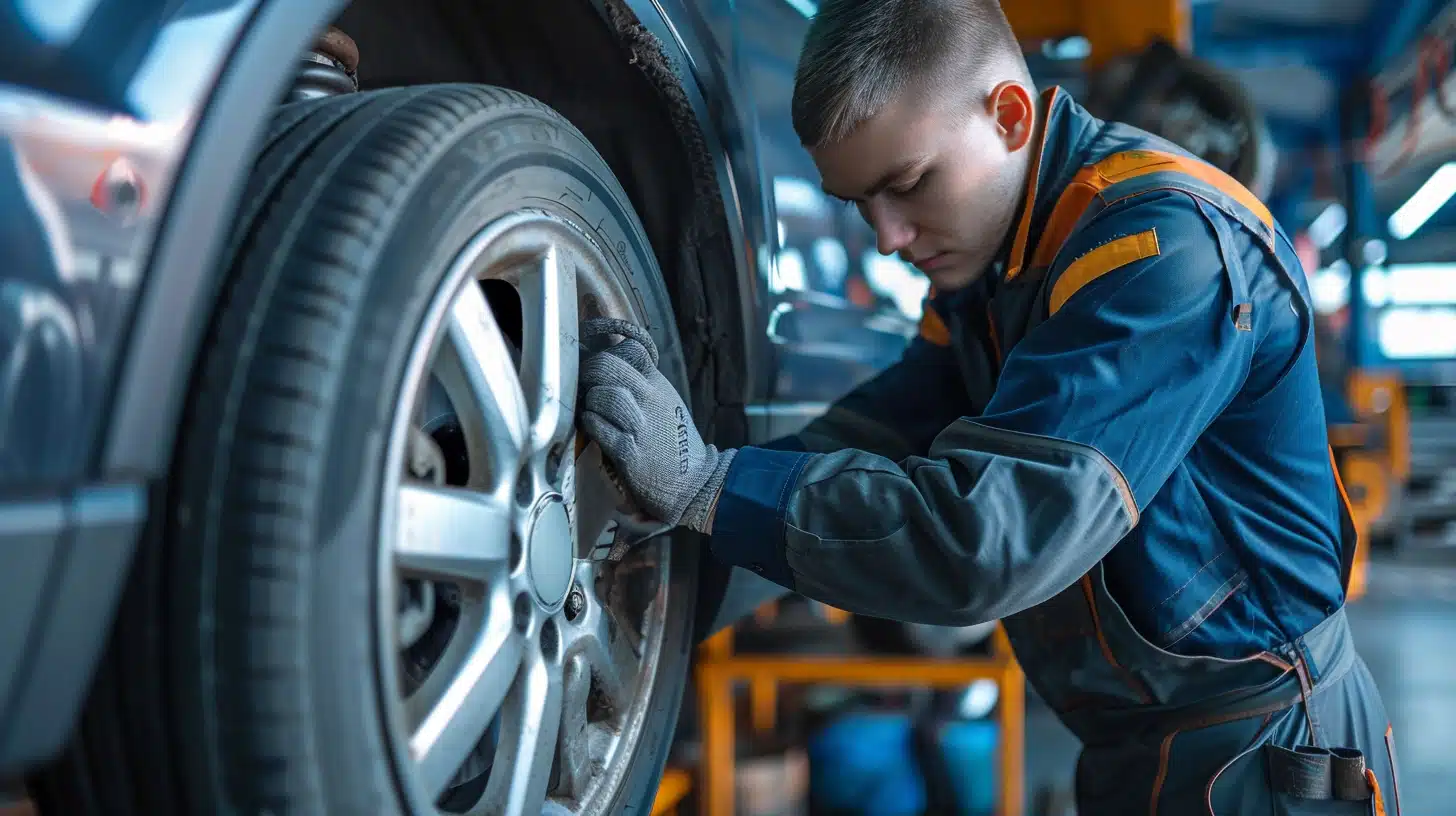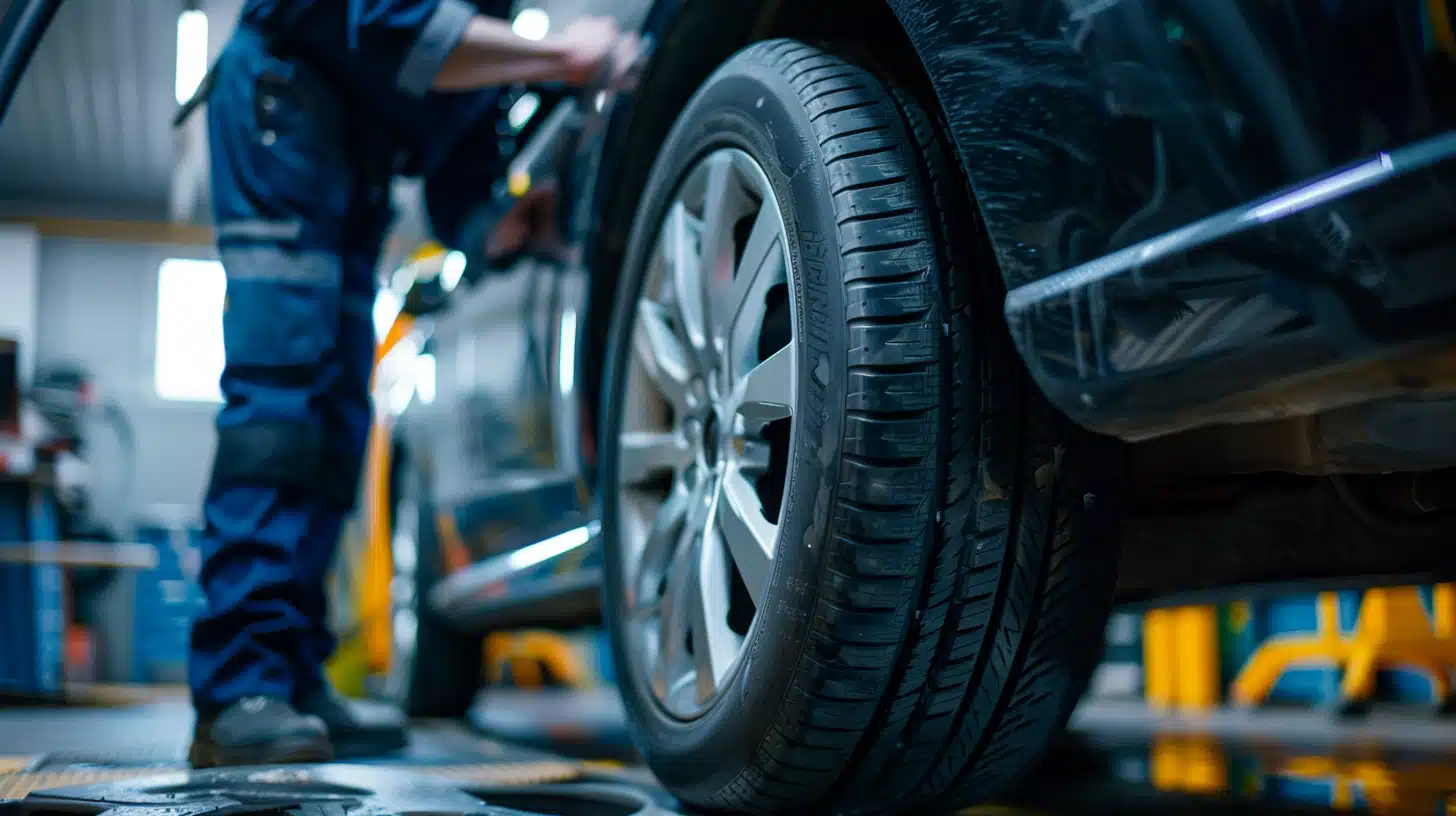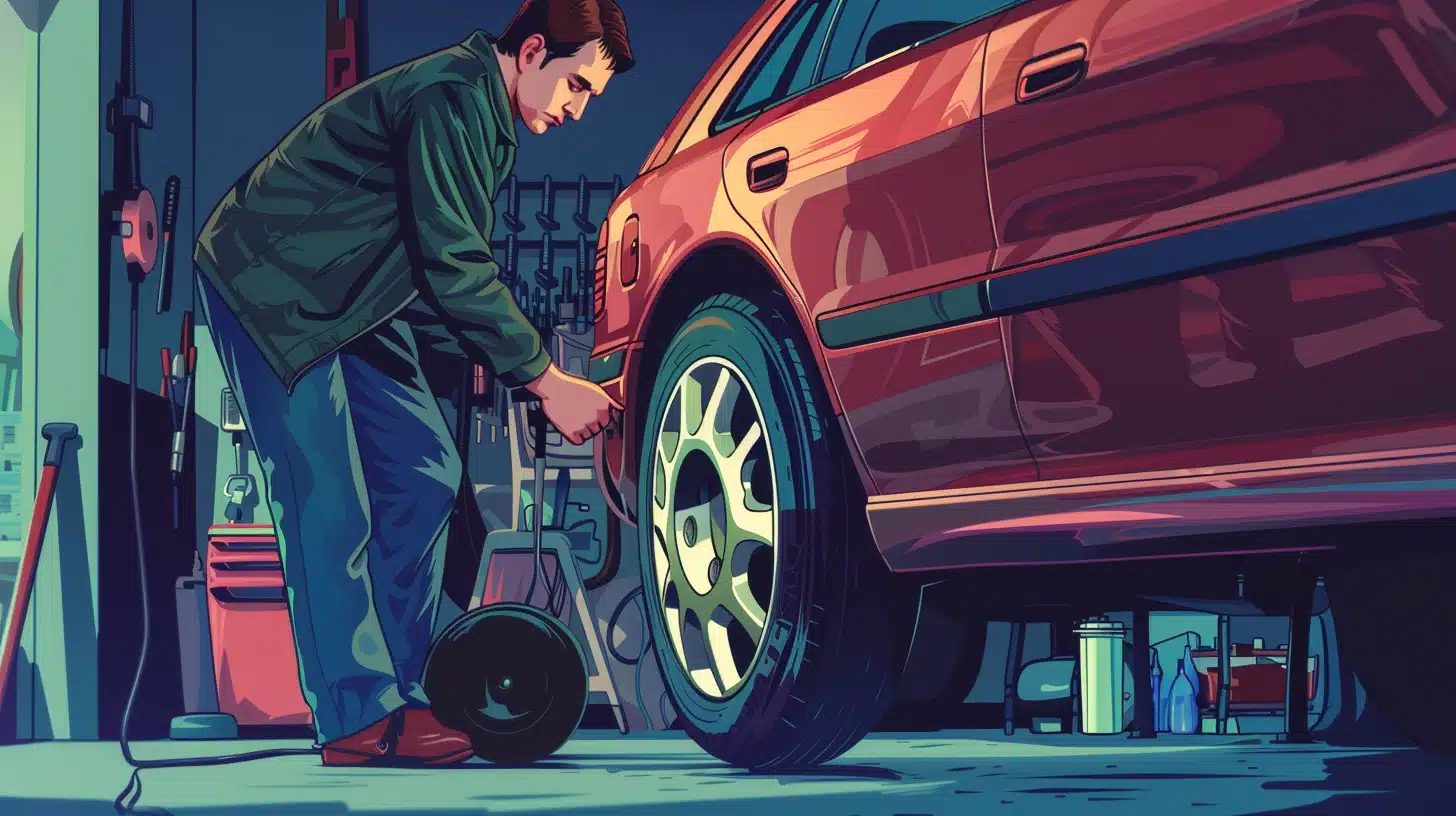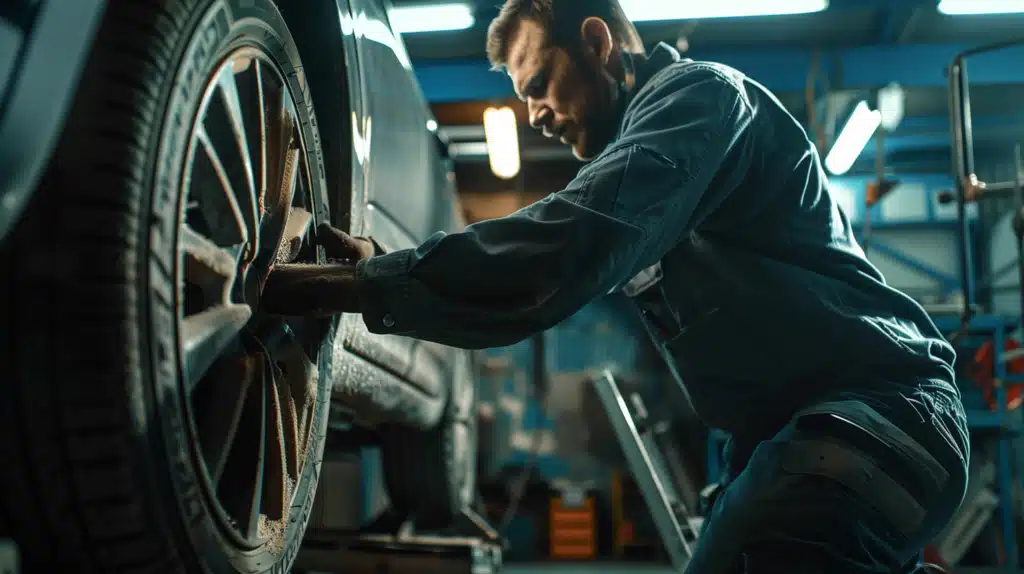Is your car pulling to one side or shaking on the highway? Sounds like you might need a wheel alignment.
But with shop prices soaring, who wants to pay for such a straightforward fix?
You can align your wheels at home and save big.
In this guide, we’ll walk you through the steps to align your wheel and discuss the benefits and drawbacks of going the DIY route.
We’ll cover the tools you need, the basic process, and how to know if you’ve got it right.
By the end, you’ll know to decide if a DIY wheel alignment is right for you and your vehicle. Let’s get started!
Tools for DIY Wheel Ailment

Before diving into the DIY wheel alignment process, consider the essential tools you’ll need.
The most critical item is an alignment kit, which typically includes toe plates, camber gauges, and a steering wheel holder.
You’ll also need a set of wrenches, specifically a 24mm wrench for adjusting tie rods and a 13mm wrench for various nuts and bolts.
A camber gauge is another must-have tool, as it allows you to accurately measure the camber angle of your wheels.
Investing in quality brands can significantly improve the accuracy and durability of tools.
Top brands like Longacre, Intercomp, and QuickTrick are known for their reliability for alignment kits.
If you’re on a tighter budget, there are cost-effective alternatives available on online retailers like Amazon or eBay that can still get the job done.
Just be sure to read reviews and compare features before making a purchase.
Workspace Requirements

A proper workspace is crucial for a successful and safe DIY wheel alignment.
You’ll need a flat, level surface with ample space to work around your vehicle.
Ensure you have good lighting, whether from overhead or portable work lights, to enhance visibility and reduce the risk of accidents.
Safety should always be a top priority.
Wear personal protective gear like gloves and safety glasses, and make sure your vehicle is securely positioned with wheel chocks.
If you need to lift the vehicle, use jack stands and double-check their placement before getting under the car.
Proper ventilation is essential, especially when working in an enclosed garage.
Open windows and doors, and consider using fans to circulate fresh air.
Keep your workspace clean and free from oil spills or clutter to prevent slips and trips.
If you’re on a tight budget, there are DIY alternatives you can try.
Scrap metal and a drill can be used to make homemade toe-in plates, while a simple string setup can help you check the alignment of your wheels.
Look for tutorials online or in auto enthusiast forums for step-by-step instructions.
Pre-Wheel Alignment Checks
Vehicle Preparation
Before starting your wheel alignment, it’s crucial to position your car correctly on a flat, level surface.
This ensures accurate measurements and adjustments.
If your workspace isn’t perfectly level, use ramps or shims to level the vehicle.
Place wheel chocks around the tires to prevent the car from rolling during alignment.
Next, thoroughly clean your wheels and tires. Remove any debris, mud, or snow that could interfere with your measurements.
Use a pressure washer or hose to rinse off the wheels, and then dry them with a clean towel.
Pay extra attention to the area around the tire valve stem, as this is a common spot for accumulating dirt and grime.
Inspection for Wear or Damage
Before making any adjustments, visually inspect your tires and suspension components.
Check for uneven wear patterns on the tire tread, which can indicate existing alignment issues.
Look for signs of wear on the inner or outer edges of the tire, as this can suggest improper camber or toe settings.
Inspect your suspension components for visible damage or wear, including tie rods, ball joints, and bushings.
Worn or loose components can affect your alignment measurements and should be replaced before proceeding.
Document your findings, including any measurements or observations, to compare with your post-adjustment results.
This will help you track your vehicle’s alignment history and identify recurring issues.
Initial Measurement Techniques
Using your alignment tools, take initial measurements of your vehicle’s toe, camber, and caster angles.
Use a tape measure for the toe to check the distance between each tire’s front and rear.
Measure from the same point on each tire, such as the tread center or the rim edge.
Use a camber gauge positioned vertically against the wheel to measure the camber.
Ensure the indicator is flush with the wheel and not touching the tire.
Record the angle reading from the gauge.
Caster is more challenging to measure without specialized tools, but you can get a general idea by observing the angle of the steering axis.
If the top of the axis leans toward the vehicle’s rear, you have a positive caster. If it leans toward the front, you have a negative caster.
Compare your measurements to the manufacturer’s specifications for your vehicle, usually found in the owner’s manual or online.
Note any discrepancies, as these will guide your adjustment process.
Stepwise Guide to Adjusting Wheel Alignment
1. Adjusting Toe

Set up your string or toe plates around the vehicle to adjust the toe.
Attach a string to each tire’s front and rear for the string method, ensuring it’s taut and level.
Measure the distance between the strings at the front and rear of the tires.
If the front measurement is greater, you have to toe out. If the rear measurement is greater, you have to toe in.
Adjust the tie rods using a wrench to bring the toe measurements within the manufacturer’s specifications.
Make small adjustments, and recheck your measurements after each adjustment. Be sure to adjust both sides of the vehicle equally to maintain symmetry.
2. Adjusting Camber

Camber adjustment typically requires the use of shims or adjustable control arms.
Positive camber means the top of the tire leans outward, while negative camber means the top leans inward.
First, loosen the bolts that secure the strut to the spindle.
Then, insert the appropriate size shim between the two components to adjust the camber angle.
Use your camber gauge to check the angle as you make adjustments.
If your vehicle has adjustable control arms, follow the manufacturer’s instructions for adjusting the camber.
Typically, this involves loosening the bolts that secure the arm to the frame and rotating the arm to achieve the desired camber angle.
3. Adjusting Caster
The caster is the angle of the steering axis when viewed from the side of the vehicle.
Positive caster means the top of the axis leans toward the car’s rear, which provides stability and helps the steering wheel return to the center after a turn.
Adjusting the caster is more complex than changing the toe or camber and often requires specialized tools.
In most cases, it’s best to leave caster adjustments to a professional mechanic.
However, if you attempt to adjust the caster, follow the manufacturer’s instructions carefully and take all necessary safety precautions.
Post-Wheel Alignment Procedures
After completing your adjustments, recheck all your measurements to ensure they are within the manufacturer’s specifications.
Measure the toe, camber, and caster at each wheel and compare the values to your initial measurements.
Take your vehicle for a test drive to verify that the alignment feels correct.
Pay attention to how the steering wheel centers after a turn and whether the vehicle pulls to one side or the other.
If you notice any issues, return to your workspace and make further adjustments as needed.
Maintenance Tips for Wheel Alignments
- To maintain your vehicle’s alignment, perform regular maintenance checks at least once a year or whenever you notice symptoms of misalignment.
- Check for uneven tire wear, steering pull, or vibration while driving.
- If you frequently drive on rough roads or participate in motorsports, check your alignment more often.
- Hitting a large pothole, curb, or debris can knock your alignment out of spec and cause premature tire wear.
Pros and Cons of DIY Wheel Alignment
Advantages
- Cost savings compared to professional alignment services.
- Educational experience and a better understanding of vehicle mechanics.
- The convenience of performing an alignment on your schedule.
Disadvantages
- Risk of improper alignment causing uneven tire wear or handling issues.
- A time-consuming process, especially for beginners.
- Requires investment in specialized tools and equipment.
Troubleshooting for Wheel Alignments
Some Common Wheel Alignment Issues
- Incorrect toe settings causing rapid tire wear or steering pull
- Uneven camber causing tire wear on one side of the tread
- Improper caster settings affecting steering stability and returnability
Symptom Identification
- Rapid or uneven tire wear
- Vehicle pulling to one side while driving
- Steering wheel off-center when driving straight
- Steering wheel vibration or shimmy
Problem Diagnosis
- Measure toe, camber, and caster settings and compare to manufacturer specifications.
- Inspect suspension components for wear or damage.
- Check tire pressure and condition.
Solution Implementation
- Readjust toe settings using tie rods to correct steering pull or uneven wear
- Adjust camber using shims or control arms to even out tire wear
- Replace worn suspension components that may be affecting alignment
Conclusion
performing a DIY wheel alignment can be a cost-effective and educational experience for car enthusiasts.
Following the step-by-step guide and using the right tools can achieve proper alignment and improve your vehicle’s handling, tire wear, and overall performance.
However, it is essential to weigh the pros and cons before embarking on this project, as improper alignment can lead to safety risks and further issues.
If you’re up for the challenge and have the time and patience to learn, a DIY wheel alignment can be a rewarding experience.
But if you’re unsure or uncomfortable with the process, it’s always best to seek the help of a professional.
Regardless of your choice, regular maintenance and alignment checks are crucial for keeping your vehicle in optimal condition.


